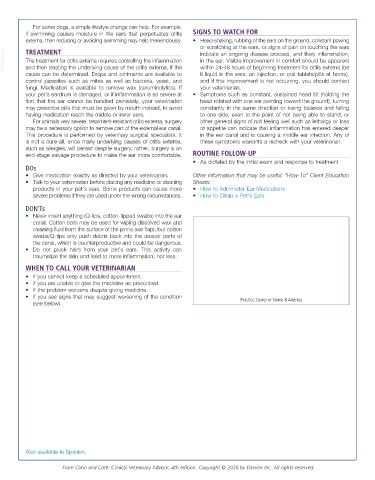Page 3094 - Cote clinical veterinary advisor dogs and cats 4th
P. 3094
For some dogs, a simple lifestyle change can help. For example,
if swimming causes moisture in the ears that perpetuates otitis SIGNS TO WATCH FOR
externa, then reducing or avoiding swimming may help tremendously. • Head-shaking, rubbing of the ears on the ground, constant pawing
or scratching at the ears, or signs of pain on touching the ears
TREATMENT
VetBooks.ir The treatment for otitis externa requires controlling the inflammation in the ear. Visible improvement in comfort should be apparent
indicate an ongoing disease process, and likely inflammation,
within 24-48 hours of beginning treatment for otitis externa (be
and then treating the underlying cause of the otitis externa, if the
cause can be determined. Drops and ointments are available to it liquid in the ears, an injection, or oral tablets/pills at home),
control parasites such as mites as well as bacteria, yeast, and and if this improvement is not occurring, you should contact
fungi. Medication is available to remove wax (ceruminolytics). If your veterinarian.
your pet’s eardrum is damaged, or if inflammation is so severe at • Symptoms such as constant, sustained head tilt (holding the
first that the ear cannot be handled painlessly, your veterinarian head rotated with one ear pointing toward the ground), turning
may prescribe pills that must be given by mouth instead, to avoid constantly in the same direction or losing balance and falling
having medication reach the middle or inner ears. to one side, even to the point of not being able to stand, or
For animals very severe, treatment-resistant otitis externa, surgery other general signs of not feeling well such as lethargy or loss
may be a necessary option to remove part of the external ear canal. of appetite can indicate that inflammation has entered deeper
This procedure is performed by veterinary surgical specialists. It in the ear canal and is causing a middle ear infection. Any of
is not a cure-all, since many underlying causes of otitis externa, these symptoms warrants a recheck with your veterinarian.
such as allergies, will persist despite surgery; rather, surgery is an
end-stage salvage procedure to make the ear more comfortable. ROUTINE FOLLOW-UP
• As dictated by the initial exam and response to treatment.
DOs
• Give medication exactly as directed by your veterinarian. Other information that may be useful: “How-To” Client Education
• Talk to your veterinarian before placing any medicine or cleaning Sheets:
products in your pet’s ears. Some products can cause more • How to Administer Ear Medications
severe problems if they are used under the wrong circumstances. • How to Clean a Pet’s Ears
DON’Ts
• Never insert anything (Q-tips, cotton-tipped swabs) into the ear
canal. Cotton balls may be used for wiping dissolved wax and
cleaning fluid from the surface of the pinna (ear flap), but cotton
swabs/Q-tips only push debris back into the deeper parts of
the canal, which is counterproductive and could be dangerous.
• Do not pluck hairs from your pet’s ears. This activity can
traumatize the skin and lead to more inflammation, not less.
WHEN TO CALL YOUR VETERINARIAN
• If you cannot keep a scheduled appointment.
• If you are unable to give the medicine as prescribed.
• If the problem worsens despite giving medicine.
• If you see signs that may suggest worsening of the condition
(see below). Practice Stamp or Name & Address
Also available in Spanish.
From Cohn and Côté: Clinical Veterinary Advisor, 4th edition. Copyright © 2020 by Elsevier Inc. All rights reserved.

